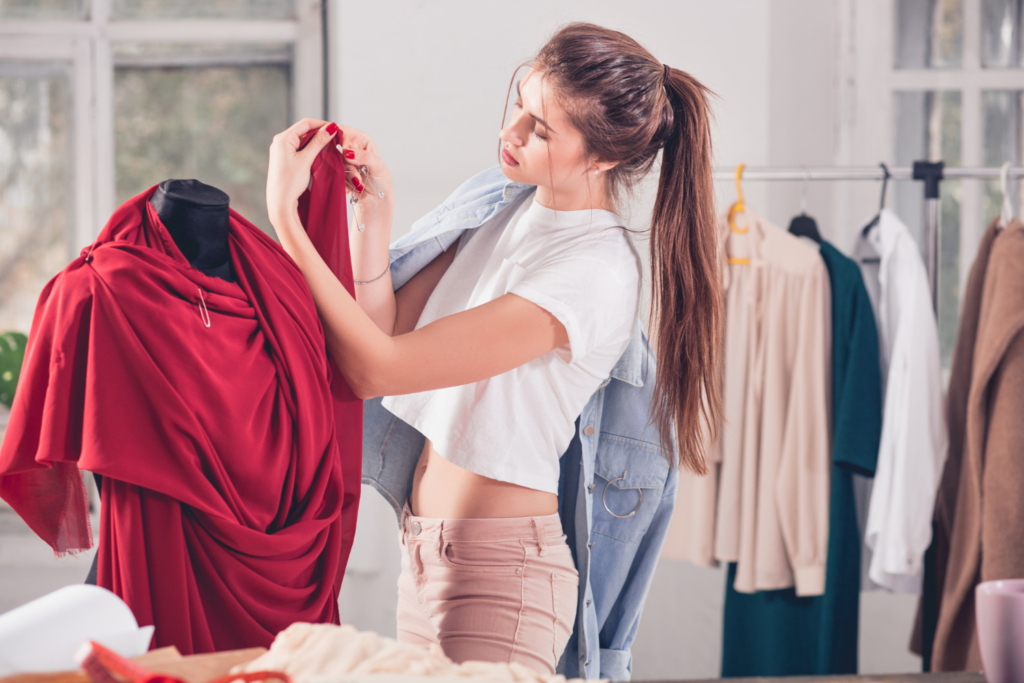Summary
- Clothing fit is the harmonious adjustment between the structure of the garment and the body’s curves.
- A good fit makes all the difference in the final quality of clothing, impacting the success of a collection.
- Simulate adjustments before final production. Try the Audaces360 multi-solution for free.
A clothing fit is a delicate and crucial aspect of a collection’s success. It can be the finishing touch after consistent development work. However, if neglected, it can jeopardize the entire effort.
Fortunately, you can avoid these unpleasant surprises.
First, we will highlight the importance of patternmaking in clothing fit and identify four common mistakes. Then, we will provide practical tips and technological solutions that guarantee an ideal fit.
Happy reading!
Sumário
What is clothing fit?
Clothing fit is the subtle balance between a garment’s structure and the body’s natural curves. It influences both the aesthetics and comfort of the pieces.
It’s easy to tell when a garment fits well. The fabric adjusts seamlessly and smoothly. Fit is a quality that sets collections apart, resulting from good patternmaking and the right fabric choice.
How important is patternmaking for the perfect fit?
Creating patterns is one of the most crucial steps in clothing production.
The fit of clothing directly depends on a well-tested and approved pattern, as these patterns serve as templates for all pieces. Knowledge of geometry, math, statistics, and technical drawing is essential in this process.
In summary, patternmaking involves five steps before clothing production:
- Design sketch.
- Fabric selection.
- Measurement taking.
- Base pattern creation.
- Pattern adjustments.
These steps also involve close collaboration between stylists and pattern makers.
Learn more: Learn when to use each modeling technique and how to choose them wisely
4 common mistakes when producing well-fitting clothes

From the first pattern measurements to fabric cutting, good fit is in the details. In the daily routine of production, we sometimes go into ‘automatic mode,’ and problems occur.
We analyzed the clothing development process and identified the most common mistakes that compromise a good fit:
1) Incorrect measurements
Imprecise numbers, hard-to-understand drawings, lack of attention… the causes vary.
But the result of incorrect measurements is always similar: clothes that are too loose or too tight.
This is how you end up with sleeves that are too long, buttons that don’t close properly, or excessive folds in the pant legs.
2) Inadequate fabric choice
Each material has specific characteristics that affect how the garment fits.
When the choice of materials—along with their elasticity, weight, and texture—is not aligned with the garment’s design, the clothing fit is compromised.
3) Lack of fit simulation
Even with the ideal fabrics chosen, the fit simulation is where they are put to the test. Skipping this process can lead to adjustments needed after production.
The consequences? Delivery delays, material waste, and reduced profits in production.
4) Incorrect cutting and lack of layering
Correct measurements, well-chosen fabrics, and complete simulations. Yet, an imprecise cut can jeopardize everything. Improper layering, or the lack of it, can do the same.
When fabric layers are not correct, the cut pieces lose quality. These differences affect clothing fits.
How to produce well-fitting garments?

Now that we know what to avoid, let’s think about practical solutions. These are tips you can quickly implement to ensure a more precise clothing fit in your productions.
Create a base pattern
Develop a base pattern that will serve as a reference to adjust and adapt the garment. A good base pattern is the foundation for perfect fit.
Validate the measurements with the Style team to ensure the numbers are correct.
Select good fabrics
Study the available options well, ask for samples, and do lots of testing.
Each material has its own clothing fit—elasticity, weight, and fluidity—which you can confirm during testing. Consider using technologies for material organization and pre-cost calculation, like Audaces Idea.
To help with your selection, here are some fabrics and their main characteristics:
- Silk: Made from the cocoon of the silkworm, it’s a lightweight and very delicate fabric. Its fit is flowy.
- Jeans: A classic that works for both structured garments and those with more movement. Its fit varies depending on the composition and thickness.
- Tricoline: Versatile, made of 100% cotton, it’s a non-elastic fabric with a good fit for shirts, skirts, dresses, and tunics, for example.
- Satin: As fine as silk but shinier. 100% polyester satin has no elasticity and is more structured. Meanwhile, satin with elastane is lighter and has a casual fit.
- Knit: 100% synthetic, it’s lightweight and soft. Its elasticity provides more freedom of movement when worn.
- Zimbeline: Made of 100% polyester, it has no elasticity. A well-structured fabric, it doesn’t wrinkle and has a good fit for formal wear like evening gowns.
- Oxford: Durable, wrinkle-free, and shrink-resistant. Its lighter variation is known as Oxfordine. The former is more structured, while the latter has a soft fit.
- Microfiber: Made from fine polyester threads, microfiber has no elasticity and is highly durable. It has a good fit in sportswear, bikinis, swimsuits, and trunks.
Adjust for the desired style
Oversized, straight, fitted, flared—the styles of clothing are also diverse. Along with the type of fabric, it’s one of the factors that most influence the fit.
When style and fabric complement each other coherently, a good fit comes naturally.
Simulate the fit clothing and adjust
The importance of testing for a good fit is already clear, right?
To do this, use prototypes and run many simulations. You can also adjust fit virtually with software like Audaces 3D.
How does technology help create perfect clothing fit?
Based on what we’ve covered, four factors stand out in achieving perfect fit. They are patternmaking, material selection, simulation, and cutting precision.
Technology has transformed the fashion industry year after year with interesting innovations:
- In pattern making: It’s now possible to create 100% digital patterns, organized and saved in the cloud. This means less material waste and easier access to information.
- In material selection: PLM (Product Lifecycle Management) software facilitate the organization of materials for each piece in the collection, with automatic pre-cost calculations.
- In simulation: Once requiring real mannequins and lots of materials, simulations can now be entirely digital. You can make changes instantly, speeding up the process.
- In cutting precision: For larger productions, cutting rooms with embedded software automate the layering and cutting of fabrics. For manual cutting, programs adjust the patterns to fabric pieces in an optimized way, increasing efficiency.
Learn more: 9 fabrics with the perfect fit to use in your fashion collection
100% digital clothing simulation for patterns and fit
Many of the mistakes that compromise a good fit happen due to lack of attention and/or imprecision.
Technology helps with both. Here at Audaces, we’ve developed two solutions that make a big difference in clothing fit:
Audaces Pattern
Audaces Pattern allows you to create high-quality, precise patterns—regardless of complexity, size, or details. Everything is 100% digital.
It helps with clothing fit by providing accurate patterns that enable precise cutting. The garments have a high standard of quality without the need for post-production adjustments.
Audaces 3D
With Audaces 3D, you can create designs on three-dimensional mannequins, using various tools and customizations. Assess the fit of different fabrics with just one click.
Run as many simulations as you need without wasting materials, ensuring the fit is as expected.
Now that you know how to avoid mistakes and get a good clothing fit, download our free e-book! It explains how pattern making and fitting can speed up your production.
FAQ
Clothing fit is the subtle balance between a garment’s structure and the body’s natural curves. It influences both the aesthetics and comfort of the pieces.
Incorrect measurements, inadequate fabric selection, lack of fit simulation, and incorrect cutting/lack of fabric layering.
Select good fabrics, create a base pattern, adjust for the desired style, and simulate the fit by making the necessary adjustments.










